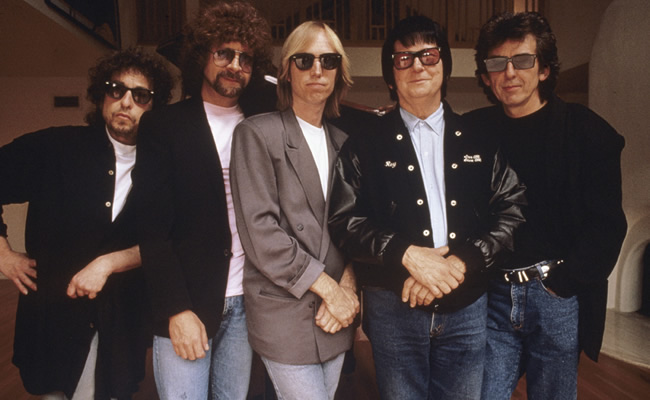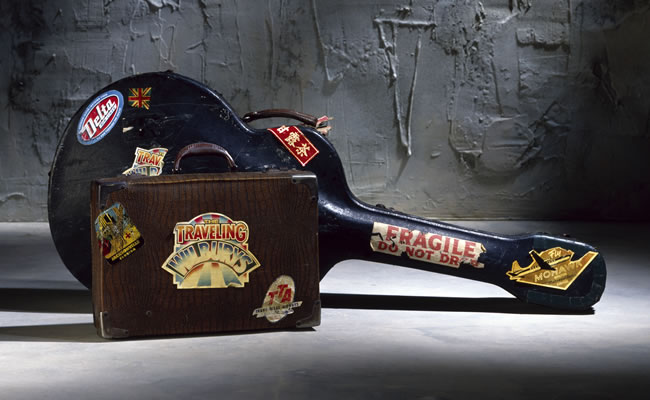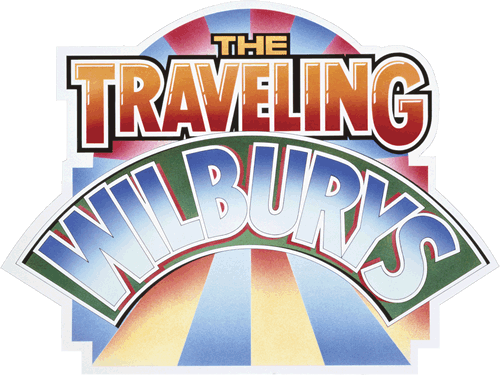THE HISTORY OF THE TRAVELING WILBURYS
Which one do you believe...
By Mo Ostin
The birth of the Traveling Wilburys was a happy accident. Warner Bros. Records’ International Department had asked that George Harrison come up with a B-side for “This Is Love,” a single from his Cloud Nine album. At the time it was customary to couple an A-side with a never-before-heard track, giving the single extra sales value.
This was mid-1988. Cloud Nine was just out. George, along with cowriter Jeff Lynne and their friends Bob Dylan, Tom Petty, and Roy Orbison, had been hanging out in Dylan’s studio. I suppose George figured that as long as his pals were on hand, why not use them to knock off this flipside?
A couple of days later George came by my office to play the new “B-side.” We went next door to A&R head Lenny Waronker’s office so he could hear it too. George played us “Handle With Care.” Our reaction was immediate. This was a song we knew could not be wasted on some B-side. Roy Orbison’s vocal was tremendous. I really loved the beautiful guitar figure that George played. The guys had really nailed it. Lenny and I stumbled over each others’ words, asking, “Can’t we somehow turn this into an album?” (I also had a suspicion that perhaps George had been hungering for another band experience.)
We urged him on. George felt the spontaneity of it, felt its driving force. He always had great instincts. Being as smart as he was he had a remarkable ability to pull people together. Think about The Concert For Bangladesh — only George Harrison could have made that happen.
Once the idea of a full, collaborative album was in front of us, George took over. The five frontmen (Harrison, Lynne, Petty, Dylan, and Orbison) decided not to use their own names. George and Jeff had been calling studio equipment (limiters, equalizers) “wilburys.” So first they named their fivesome The Trembling Wilburys. Jeff suggested “Traveling” instead. Everyone agreed.

The group was born: five guys with star stature in their own rights, but it was George who created this Wilbury environment where five stars could enjoy an ego-free collaboration. Everybody sang, everybody wrote, everybody produced — and had great fun doing so.
You can hear George’s humility and good nature reflected in the Wilburys and their music. To my thinking, this was a perfect collaboration. All five were good friends who admired and respected one another. Roy Orbison was somebody they all idolized. Of course, they revered Bob Dylan too. But Bob was closer to being their contemporary, so it was Roy who gave the project that special glow from rock ’n’ roll’s early formative years.
Reflecting on all this, I recall a few years before when my wife Evelyn and I had been in London. George had invited us to his house, Friar Park, to celebrate Evelyn’s birthday. Roy was a houseguest there at the time, so perhaps this could have been an early hint leading to the Wilburys. So, too, might it have been the time Tom, George, and Jeff (Bob wasn’t able to make it, as he’d just injured his hand) came to dinner at our house a year or so before “Handle With Care.” For us, Tom had played a new song, as yet unrecorded, called “Free Fallin’,” backed by his two future Wilbury mates. Lenny and I loved the song so much we asked Tom and the guys to do it at least three times that evening.
Perhaps even then they all were Wilburys. They just didn’t know their last name yet.
With the huge international success — over five million copies sold — of Traveling Wilburys, Volume 1, a follow-up was inevitable. George, being George, titled the second album The Traveling Wilburys, Volume 3. Sadly, by this time Roy had died, but there was still great excitement when we visited the Wilburys, recording in the Wallace Neff-designed house at the top of Coldwater Canyon. Being with those guys, in that setting — truly memorable.
I’m glad that a song that had once been destined for semiobscurity as a B-side became the catalyst for something so lasting and joyful. Rolling Stone magazine named Traveling Wilburys, Volume 1 one of the 100 Best Albums of All Time.
Mo Ostin
Chairman Emeritus
Warner Bros. Records
2007
By Tiny Hampton
The etymological origins of The Traveling Wilburys have aroused something of a controversy amongst academic circles. Did they, as Professor “Bobby” Sinfield believes, originate from the various Wilbury Fairs which traveled Europe in Medieval times, titillating the populace with contemporary ballads, or were they rather derived from, “YE TRAVELING WILBURYS”, who were popular locksmiths during the Crusades and used to pick or unlock the jammed chastity belts (rather like today’s emergency plumbers.)
Dr. Arthur Noseputty of Cambridge believes they were closely related to the Strangling Dingleberries, which is not a group but a disease. I think this can be discounted, not only because of his silly name but also from his habit of impersonating Ethel Merman during lectures. Some have even gone on to suggest tenuous links with The Pillsburys, the group who invented Flour Power.
Dim Sun, a Chinese academic, argues that they may be related to “THE STROLLING TILBURYS”, Queen Elizabeth the first’s favourite minstrels, and backs this suspicion with the observation that The Traveling Wilburys is an obvious anagram of “V. BURYING WILL’S THEATRE”, clearly a reference to the closing of Shakespeare’s Globe theatre by Villiers during an outbreak of the plague. This would account for the constant traveling. Indeed, many victims of the plague and St.Vitus’ dance literally danced themselves to death, and it is this dancing theme that resurfaces with The Wilbury Twist. Not a cocktail but a dance craze, reminiscent of The Wilbury Quadrille made famous at Bath in 1790 by Beau Diddley, and the Wilbury Waltz, which swept Vienna in the 1890’s.
One thing, however, remains certain. The circumambulatory peregrinations of these itinerant mundivagant peripatetic nomads has already disgorged one collection of popular lyrical cantata, which happily encapsulated their dithyrambic antiphonic contrapuntal threnodies as a satisfactory auricular experience for the hedonistic gratification of the hoi-polloi on a popular epigraphically inscribed gramophonic recording. Now here’s another one.
Professor “TINY” Hampton is currently leading the search for Intelligent Life amongst Rock Journalism at the University of Please Yourself, California.

By Hugh Jampton
The original Wilburys were a stationary people who, realizing that their civilization could not stand still forever, began to go for short walks — not the “traveling”, as we now know it, but certainly as far as the corner and back. They must have taken to motion, in much the same way as penguins were at that time taking to ledges, for the next we hear of them they were going out for the day (often taking lunch or a picnic). Later, we don’t as yet know how much later, some intrepid Wilburys began to go away for the weekend, leaving late Friday and coming back Sunday. It was they who evolved simple rhythmic forms to describe their adventures.
A remarkable sophisticated musical culture developed, considering there were no managers or agents, and the further the Wilburys traveled the more adventurous their music became, and the more it was revered by the elders of the tribe who believed it had the power to stave off madness, turn brunettes into blondes and increase the size of their ears.
As the Wilburys began to go further and further in their search for musical inspiration they found themselves the object of interest among many less developed species — nightclub owners, tour operators and recording executives. To the Wilburys, who had only just learnt to cope with wives, roadies and drummers, it was a blow from which many of them never recovered.
A tiny handful survived — the last of the Traveling Wilburys — and the songs gathered here represent the popular laments, the epic and heroic tales, which characterize the apotheosis of the elusive Wilbury sound. The message of the music travels, as indeed they traveled and as I myself must now travel for further treatment. Good listening, good night and let thy Wilbury be done . . .
Hugh Jampton, E.F. Norti-Bitz Reader in Applied Jacket, University of Krakatoa (East of Java)
